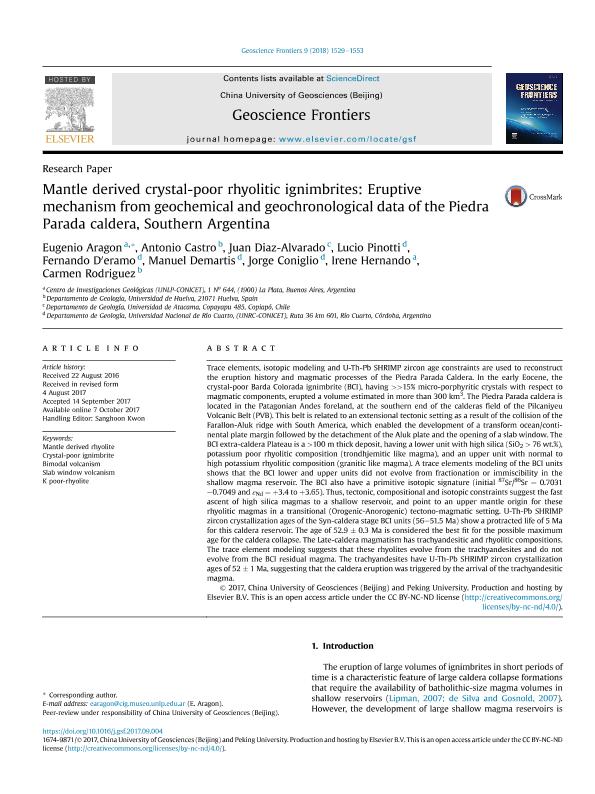Mostrar el registro sencillo del ítem
dc.contributor.author
Aragon, Eugenio

dc.contributor.author
Castro, Antonio
dc.contributor.author
Diaz Alvarado, Juan
dc.contributor.author
Pinotti, Lucio Pedro

dc.contributor.author
D'eramo, Fernando Javier

dc.contributor.author
Demartis, Manuel

dc.contributor.author
Coniglio, Jorge Enrique

dc.contributor.author
Hernando, Irene Raquel

dc.contributor.author
Rodriguez, Carmen
dc.date.available
2018-06-19T15:18:17Z
dc.date.issued
2017-12
dc.identifier.citation
Aragon, Eugenio; Castro, Antonio; Diaz Alvarado, Juan; Pinotti, Lucio Pedro; D'eramo, Fernando Javier; et al.; Mantle derived crystal-poor rhyolitic ignimbrites: Eruptive mechanism from geochemical and geochronological data of the Piedra Parada caldera, Southern Argentina; Elsevier Science; Geoscience Frontiers; 8; 4; 12-2017; 1-26
dc.identifier.issn
1674-9871
dc.identifier.uri
http://hdl.handle.net/11336/49255
dc.description.abstract
Trace elements, isotopic modeling and U-Th-Pb SHRIMP zircon age constraints are used to reconstruct the eruption history and magmatic processes of the Piedra Parada Caldera. In the early Eocene, the crystal-poor Barda Colorada ignimbrite (BCI), having >>15% micro-porphyritic crystals with respect to magmatic components, erupted a volume estimated in more than 300 km3. The Piedra Parada caldera is located in the Patagonian Andes foreland, at the southern end of the calderas field of the Pilcaniyeu Volcanic Belt (PVB). This belt is related to an extensional tectonic setting as a result of the collision of the Farallon-Aluk ridge with South America, which enabled the development of a transform ocean/continental plate margin followed by the detachment of the Aluk plate and the opening of a slab window. The BCI extra-caldera Plateau is a >100 m thick deposit, having a lower unit with high silica (SiO2 > 76 wt.%), potassium poor rhyolitic composition (trondhjemitic like magma), and an upper unit with normal to high potassium rhyolitic composition (granitic like magma). A trace elements modeling of the BCI units shows that the BCI lower and upper units did not evolve from fractionation or immiscibility in the shallow magma reservoir. The BCI also have a primitive isotopic signature (initial 87Sr/86Sr = 0.7031-0.7049 and ε Nd = +3.4 to +3.65). Thus, tectonic, compositional and isotopic constraints suggest the fast ascent of high silica magmas to a shallow reservoir, and point to an upper mantle origin for these rhyolitic magmas in a transitional (Orogenic-Anorogenic) tectono-magmatic setting. U-Th-Pb SHRIMP zircon crystallization ages of the Syn-caldera stage BCI units (56-51.5 Ma) show a protracted life of 5 Ma for this caldera reservoir. The age of 52.9 ± 0.3 Ma is considered the best fit for the possible maximum age for the caldera collapse. The Late-caldera magmatism has trachyandesitic and rhyolitic compositions. The trace element modeling suggests that these rhyolites evolve from the trachyandesites and do not evolve from the BCI residual magma. The trachyandesites have U-Th-Pb SHRIMP zircon crystallization ages of 52 ± 1 Ma, suggesting that the caldera eruption was triggered by the arrival of the trachyandesitic magma.
dc.format
application/pdf
dc.language.iso
eng
dc.publisher
Elsevier Science

dc.rights
info:eu-repo/semantics/openAccess
dc.rights.uri
https://creativecommons.org/licenses/by-nc-nd/2.5/ar/
dc.subject
Bimodal Volcanism
dc.subject
Crystal-Poor Ignimbrite
dc.subject
K Poor-Rhyolite
dc.subject
Mantle Derived Rhyolite
dc.subject
Slab Window Volcanism
dc.subject.classification
Meteorología y Ciencias Atmosféricas

dc.subject.classification
Ciencias de la Tierra y relacionadas con el Medio Ambiente

dc.subject.classification
CIENCIAS NATURALES Y EXACTAS

dc.title
Mantle derived crystal-poor rhyolitic ignimbrites: Eruptive mechanism from geochemical and geochronological data of the Piedra Parada caldera, Southern Argentina
dc.type
info:eu-repo/semantics/article
dc.type
info:ar-repo/semantics/artículo
dc.type
info:eu-repo/semantics/publishedVersion
dc.date.updated
2018-06-18T21:36:18Z
dc.journal.volume
8
dc.journal.number
4
dc.journal.pagination
1-26
dc.journal.pais
Países Bajos

dc.journal.ciudad
Amsterdam
dc.description.fil
Fil: Aragon, Eugenio. Consejo Nacional de Investigaciones Científicas y Técnicas. Centro Científico Tecnológico Conicet - La Plata. Centro de Investigaciones Geológicas. Universidad Nacional de La Plata. Facultad de Ciencias Naturales y Museo. Centro de Investigaciones Geológicas; Argentina
dc.description.fil
Fil: Castro, Antonio. Universidad de Huelva; España
dc.description.fil
Fil: Diaz Alvarado, Juan. Universidad de Atacama; Chile
dc.description.fil
Fil: Pinotti, Lucio Pedro. Consejo Nacional de Investigaciones Científicas y Técnicas; Argentina. Universidad Nacional de Río Cuarto. Facultad de Ciencias Exactas, Fisicoquímicas y Naturales. Departamento de Geología; Argentina
dc.description.fil
Fil: D'eramo, Fernando Javier. Consejo Nacional de Investigaciones Científicas y Técnicas; Argentina. Universidad Nacional de Río Cuarto. Facultad de Ciencias Exactas, Fisicoquímicas y Naturales. Departamento de Geología; Argentina
dc.description.fil
Fil: Demartis, Manuel. Consejo Nacional de Investigaciones Científicas y Técnicas; Argentina. Universidad Nacional de Río Cuarto. Facultad de Ciencias Exactas, Fisicoquímicas y Naturales. Departamento de Geología; Argentina
dc.description.fil
Fil: Coniglio, Jorge Enrique. Consejo Nacional de Investigaciones Científicas y Técnicas; Argentina. Universidad Nacional de Río Cuarto. Facultad de Ciencias Exactas, Fisicoquímicas y Naturales. Departamento de Geología; Argentina
dc.description.fil
Fil: Hernando, Irene Raquel. Consejo Nacional de Investigaciones Científicas y Técnicas. Centro Científico Tecnológico Conicet - La Plata. Centro de Investigaciones Geológicas. Universidad Nacional de La Plata. Facultad de Ciencias Naturales y Museo. Centro de Investigaciones Geológicas; Argentina
dc.description.fil
Fil: Rodriguez, Carmen. Universidad de Huelva; España
dc.journal.title
Geoscience Frontiers
dc.relation.alternativeid
info:eu-repo/semantics/altIdentifier/doi/https://dx.doi.org/10.1016/j.gsf.2017.09.004
dc.relation.alternativeid
info:eu-repo/semantics/altIdentifier/url/https://www.sciencedirect.com/science/article/pii/S1674987117301603
Archivos asociados
